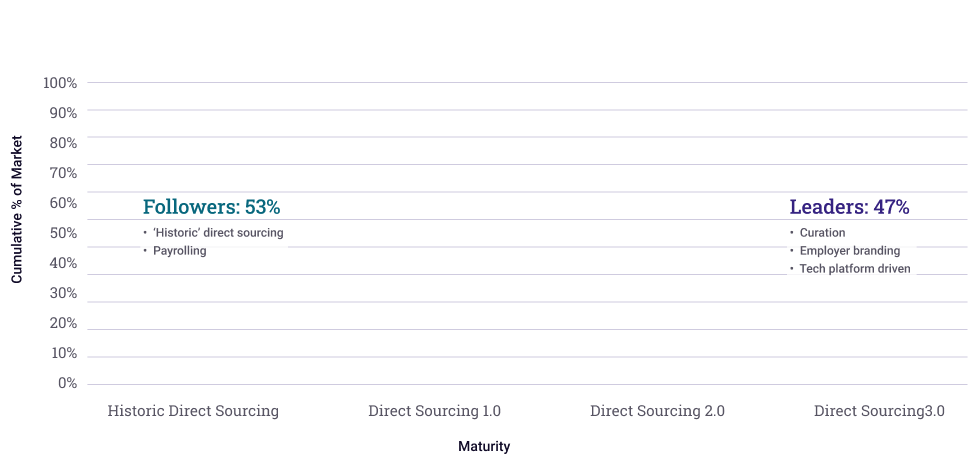2024 Trends | Part 2
Positioning for the Future of Work
The future of work is here, and preparation is key for both companies and independent professionals. MBO Partners' senior leaders offer actionable 2024 workforce recommendations, aligning skills and business focus with ever evolving client needs.
- Prepare for AI as a Major Change Agent
- Emphasize Skills, Not Jobs
- Match Skills and Talent to Solve Problems
- Make Direct Sourcing Strategic, Not Tactical
- Bring Managed Service Providers In-house
- Curate and Nurture Independent Talent
- Apply Risk Management to Wellness Goals
- Invest in Employee and Cultural Experience
- Ensure Compliance for Non-Traditional Populations
- Grow Your Talent Network Beyond US Borders
Prepare for AI as a Major Change Agent
Generative AI has already changed how people work and will continue to do so, as we covered in Part One of this report. Some of those changes will be seismic in specific industries.

For example, work is already underway in the pharmaceutical industry to establish AI-driven clinical trials. Instead of curating hundreds of live participants, an AI system could create fictional participants based on deep data sets, allowing for the efficient conduct of trials through realistic simulations that mirror diverse scenarios. This approach could work in any situation where research requires consumer group input, such as product and marketing focus groups.
Leaders need to stay up to date with developments in the AI space and include what they've learned in their business planning. Expect things to change quickly and keep strategies flexible to respond effectively to developments that could turn the industry upside down and a whole cottage industry of new skill sets and consultants - likely independent professionals - who will be tapped to help businesses best leverage the power of AI.
Emphasize Skills, Not Jobs
The call to shift to a skills-based organizational structure has long been associated with agility and nimbleness. Because such a shift can be a significant change in an enterprise - affecting workflows, processes, and even compensation models - uptake has been unsurprisingly slow. However, AI is accelerating the demand for a shift to focus on skills. Roles are no longer accurately defined, and many organizations lack the skills inventory needed to understand their people and where gaps exist. AI needs to be considered when assessing skills and skill gaps. For example, a worker who lacks good writing competency can use AI to organize their information and assist in crafting well-written content. AI can also help workers upskill rapidly to fill gaps.
Skill-based organizations are...
107%
More likely to
place talent effectively
98%
More likely to
retain high performers
79%
More likely to have a
positive company culture
49%
More likely to
improve processes
Match Skills and Talent to Solve Problems
An advantage of a skills-based organization is the ability to work backward in the hiring process. In other words, managers first define the outcome they need to achieve a goal or solve a problem. From there, they can determine the skills needed and engage talent with those skills. As AI and other tech tools become increasingly sophisticated, they can capture and analyze data that helps clearly define the desired outcome and needed skills.
This method of engaging talent can be a game-changer for many enterprises. This requires modifying hiring and procurement processes. A place to start is assessing questions and data being captured to support hiring decisions. Ensure that you are collecting the information that allows AI to provide rich support for a process that starts with the result to be produced and works backward to the right talent.

Make Direct Sourcing Strategic, Not Tactical
Though business research has shown that direct sourcing contributes materially to performance and productivity, organizations have been slow to pursue such initiatives strategically. Research published by MBO Partners and Staffing Industry Analysts in 2023 indicated that 80% of large organizations in the US either already have direct sourcing programs in place or have plans to explore this strategy in the next two years. However, less than half of those enterprises are in the mature stages of direct sourcing, strategically using technology-drive platforms, branding themselves as Clients of Choice, and curating their independent talent network.
Organizations that mature their direct sourcing in 2024 or define a clear strategy will compete most successfully for in-demand, high-value independent talent.
Half of the Market Practices 'Modern' Direct Sourcing
% Evaluating their direct sourcing programs at each maturity level


Bring Managed Service Providers In-house
Enterprises are bringing in-house the functions that had been part of their external staffing managed service provider (MSP). Establishing a team within the company to oversee the contingent labor force gives them more control over spend and strategy. Partners like MBO can provide focused expertise and insights that allow the team to keep pace with the changing contingent labor market and adjust strategies to meet enterprise needs.
A key to success for companies bringing MSP staffing in-house is cultivating good relationships with their supplier base. This is a must before any system or program can be rolled out to business units.

Curate and Nurture Independent Talent
It's not enough to direct source and engage talent compliantly to be a Client of Choice, and being a Client of Choice is a competitive imperative. You need to continually engage members of your talent network, and this starts with curating the right talent from the start. Curation requires accurate analysis of the key skills you need in your independent labor and keen focus on engaging the people with those skills. This will result in a talent network with fewer but more strategic nodes, which helps with the nurturing part of being a Client of Choice.
When you have a group of professionals with similar experience and expertise, you can create initiatives that are well-targeted to them. The overall result will be an enthusiastic and motivated pool of talent with the skills the company needs.
Becoming the Preferred Client
Incorporate them into your team
Provide opportunities for learning
Build a positive work environment
Value their work
Craft sensible processes/procedures
Apply Risk Management to Wellness Goals
Wellness programs have proven beneficial to enterprises. Such support aids employee motivation and productivity. As AI permeates the business, its use in wellness initiatives is a given. However, while using technology to track elements like workers' physical and mental health, family situations, and living conditions can be valuable in supporting employees and contractors, there's a danger of going over the line about privacy. It's essential to manage the risk of violating healthcare regulations relating to personal information.

Invest in Employee and Cultural Experience
Enterprises focused a lot on employee experience (EX) and cultural experience (CX) during the lockdown as they sought ways to maintain engagement in remote work settings. Investment and attention have waned since then, and while leaders want to move on, workers do not. There is a risk, therefore, of a disconnect in EX and CX between leadership and workers, particularly with front-line workers-those closest to a company's customers and products.
People want to be seen as humans, not numbers. Companies that invest time and money in creating the EX and CX that resonate with workers will see better bottom-line results than those that don't. This kind of employer emotional intelligence will drive performance and productivity.
Best Practices as a Manager
Build rapport with your employees
Receive periodic updates
Have regular 1-on-1 meetings
Give feedback and coaching
Solicit feedback
Ensure Compliance for Non-Traditional Populations
As organizations take advantage of the skill sets residing in the Creator Economy and occasional independents, leaders need to make sure that they comply with government regulations. With the regulatory landscape continually shifting to keep pace with non-traditional contractors, it's important to keep pace with changes in requirements.
Independent Workers Within a Typical Large Organization

Grow Your Talent Network Beyond US Borders
As companies pursue acquisition of entities outside the US, the challenges of employee integration are matched by considerations of integration and compliance for independent talent. With the growth of digital nomads in the independent population, such considerations apply even for companies that are not acquiring non-U.S. firms. In either case, expanding the talent network beyond US borders offers greater access to in-demand skills, so it's important to have the right processes and policies in place to compliantly include an international population of independent workers.

In Conclusion
It is imperative to create a workplace that lets employees, contingent labor, and AI work together The recommendations in this part of our trends report revolve around ensuring that your workforce is highly productive. While this is a familiar conversation, adding AI to the mix calls for a redefinition of that workforce. By considering AI a third type of worker that enhances the other two types' skills, decision-making, and results, leaders can create new workflows and processes that take advantage of its strengths.
Thank you to the members of MBO's leadership who contributed to this report
Miles Everson
Chief Executive Officer

John Dahlberg
SVP, Data Strategy and Governance
Audra Nichols
Chief Operating Officer

John Marcantonio
Chief Product Engineering Officer
Bob Lucas
SVP, Corporate Development
Keaton Swett
VP, Product
Cori McKee
VP, Enterprise Solutions
Kristian Rayner
Director, Enterprise Sales
Dave Cassar

McLean Robbins
VP, Marketing
Fernando Cardenas
Chief Technology Officer
Mick Lee
Chief Administrative Officer
Holly Kehrer
VP, Enterprise Solutions
Thomas Lutrell
Chief Financial Officer
Thank you to the members of MBO's leadership who contributed to this report
Miles Everson
Chief Executive Officer
Bob Lucas
SVP, Corporate Development
Dave Cassar
Holly Kehrer
VP, Enterprise Solutions

John Marcantonio
Chief Product Engineering Officer
Kristian Rayner
Director, Enterprise Sales
Mick Lee
Chief Administrative Officer
Audra Nichols
Chief Operating Officer
Cori McKee
VP, Enterprise Solutions
Fernando Cardenas
Chief Technology Officer

John Dahlberg
SVP, Data Strategy and Governance
Keaton Swett
VP, Product

McLean Robbins
VP, Marketing
Thomas Lutrell
Chief Financial Officer













